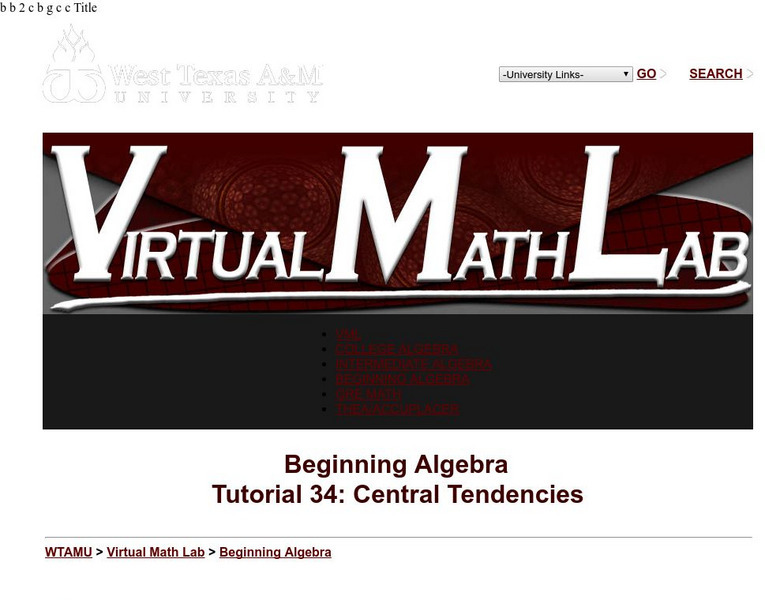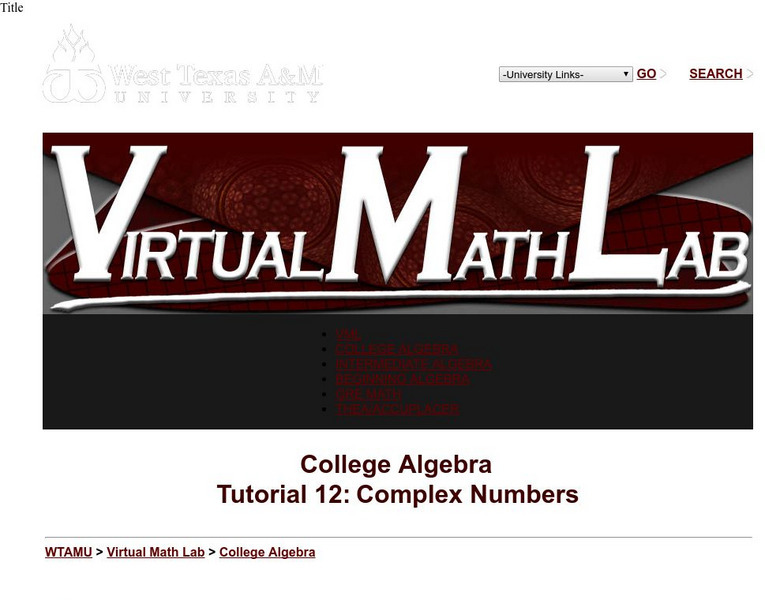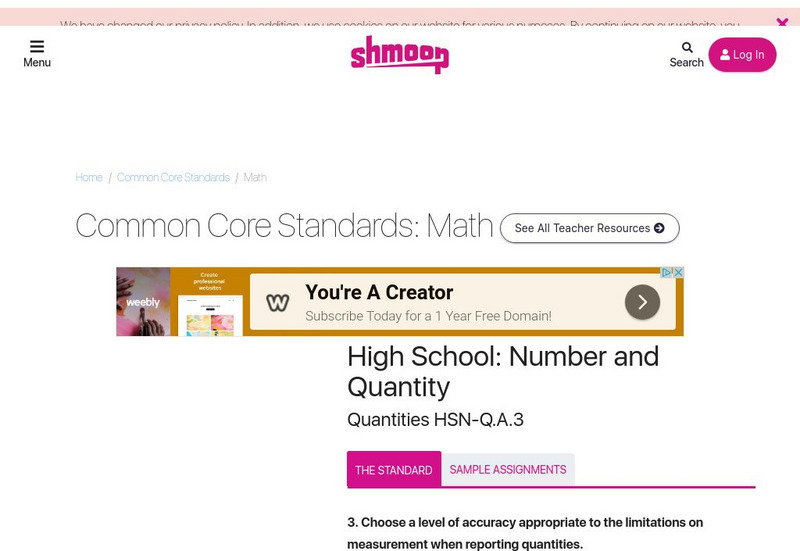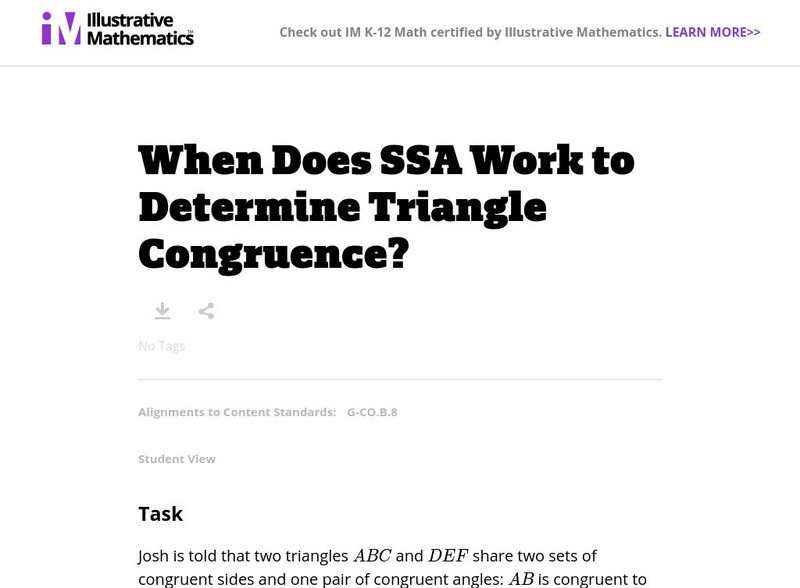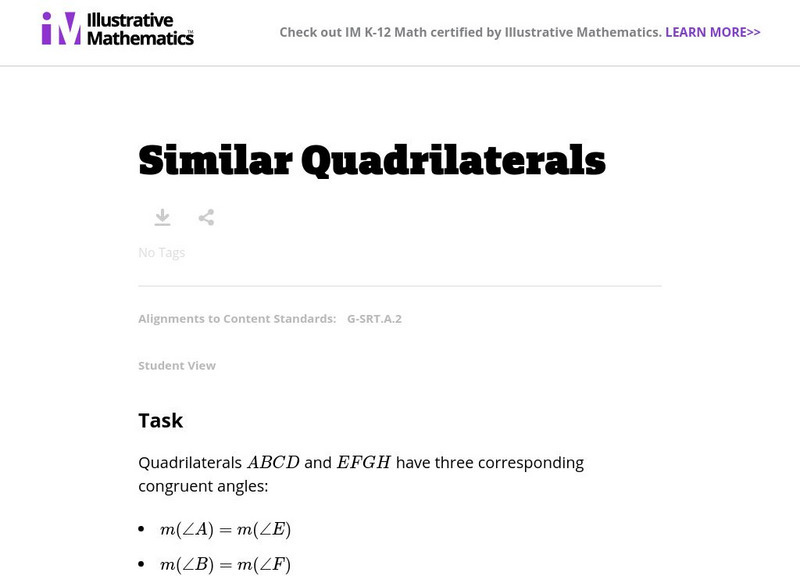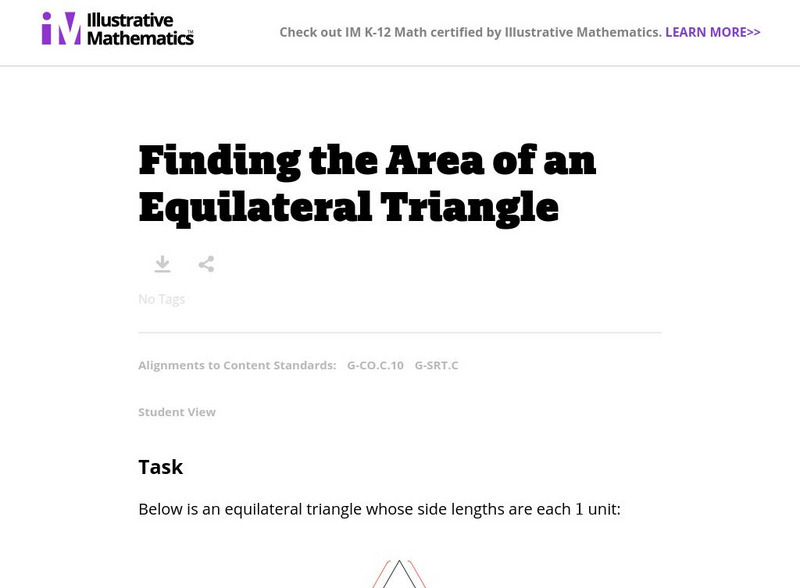Illustrative Mathematics
Illustrative Mathematics: 6.ns Multiples and Common Multiples
This task asks students to apply the concepts of multiples and common multiples in an abstract context. Aligns with 6.NS.B.4.
Better Lesson
Better Lesson: Using a Pattern to Solve a Problem
Patterns are prevalent in all levels of math. Common Core Standards expect students to be able to use structure - like that found in repeating the patterns of odd and even numbers or counting by 5s or 10s - to solve problems (MP7).
Texas A&M University
Wtamu Virtual Math Lab: Beginning Agebra: Central Tendencies
A tutorial to understand the three central tendencies and how to find them, as well as the standard deviation of values. Offers a discussion and practice problems.
Texas A&M University
Wtamu Virtual Math Lab: College Algebra: Complex Numbers
Use this tutorial to learn what imaginary and complex numbers are, how to write them, and how to perform operations with them. Offers step-by-step examples, video explanations of the examples, and practice questions with answers.
Better Lesson
Better Lesson: Time and Money
As the result of a Unit assessment, it was found that students showed some confusion with writing time and with adding sets of coins. These skills need to be reviewed to aid in mastery of the Common Core standards for time and money.
Better Lesson
Better Lesson: More Dimes and Dollars
Second graders need practice using coins and dollars and relating them to ones, tens and hundreds. Common Core standards include counting by 10s and 100s.
Better Lesson
Better Lesson: We Can Guess the Number
Understanding place value is critical to the Common Core Standards for second grade. Without a concrete understanding, 2nd graders may not fully grasp the meaning of the digits.
Better Lesson
Better Lesson: Moving Along in Hundreds
The Common Core standard is that students understand that the numbers 100, 200, etc. represent so many groups of 100.
Shmoop University
Shmoop: High School: Number and Quantity: Quantities Hsn q.a.3
Standard HSN-Q.A.3 states: "Choose a level of accuracy appropriate to limitations on measurement when reporting quantities." This page explains what this standard means. Click on 'Sample Assignments' for some quick drills.
Illustrative Mathematics
Illustrative Mathematics: N Q Giving Raises
A small company wants to give raises to their 5 employees. They have $10,000 available to distribute. Imagine you are in charge of deciding how the raises should be determined. What method would be fair to everyone? Aligns with HSN-Q.A.2.
Illustrative Mathematics
Illustrative Mathematics: N Cn Complex Distance
In this problem, you will compute some values related to the complex numbers 2 + i and 5 - 3i. Aligns with N-CN.B.6.
Illustrative Mathematics
Illustrative Mathematics: A Rei Solution Sets
For this task, students are shown the graphs of two equations, with areas bounded by their lines and intersections shaded in different colors. They are asked to write a system of equations or inequalities for each shaded area and explain...
Illustrative Mathematics
Illustrative Mathematics: A Sse Increasing or Decreasing? Variation 1
This task asks students to examine an expression that has a denominator represented by the addition of two fractions. Each of those fractions has a denominator that is a variable. They are asked to analyze the structure of the expression...
Illustrative Mathematics
Illustrative Mathematics: 6.sp Buttons: Statistical Questions
A task asking students to determine which of the six questions listed are statistical questions and which are not. Students are then asked to write a statistical question of their own.
Illustrative Mathematics
Illustrative Mathematics: Grandfather Tang's Story
The purpose of this task is for students to compose two-dimensional shapes to create a composite shape using tangram pieces. The teacher will read "Grandfather Tang's Story" and the students will use tangrams to compose the animals from...
Illustrative Mathematics
Illustrative Mathematics: G Co When Does Ssa Determine Triangle Congruence?
For this task, we are told that two triangles share two sets of congruent sides and one pair of congruent angles and that these two triangles must be congruent based on the reasoning given. Students are asked to analyze this reasoning to...
Illustrative Mathematics
Illustrative Mathematics: G Co, G Srt Congruence of Parallelograms
For this task, a student has learned the SSS and SAS congruence tests for triangles and wonders if these tests might work for parallelograms. Aligns with G-CO.C.11 and G-SRT.B.5
Illustrative Mathematics
Illustrative Mathematics: G Co Building a Tile Pattern by Reflecting Hexagons
This task applies reflections to a regular hexagon to construct a pattern of six hexagons enclosing a seventh. The focus of the task is on using the properties of reflections to deduce this seven-hexagon pattern. Aligns with G-CO.B.6.
Illustrative Mathematics
Illustrative Mathematics: G Co Is This a Parallelogram?
In the pictured quadrilateral, opposite sides are congruent and students must explain whether this makes it a parallelogram. Aligns with G-CO.C.11.
Illustrative Mathematics
Illustrative Mathematics: G Srt Ask the Pilot
In the July 2013 issue of United Airlines' Hemisphere Magazine, a pilot responded to a question about how far in the distance he could see at different altitudes. The solution involved right triangles, lines of tangency to a circle, and...
Illustrative Mathematics
Illustrative Mathematics: G Srt Folding a Square Into Thirds
The goal of this task is to apply knowledge about similar triangles in order to understand an origami construction: trisection of the side of a square. Aligns with G-SRT.B.5.
Illustrative Mathematics
Illustrative Mathematics: G Srt Similar Quadrilaterals
The goal of this task is to study if the analog of the AA criterion for similarity of triangles holds for different types of quadrilaterals. Aligns with HSG-SRT.A.2.
Illustrative Mathematics
Illustrative Mathematics: G Srt Finding the Area of an Equilateral Triangle
This task examines how to calculate the area of an equilateral triangle two ways: using triangle congruence and using trigonometric ratios. Aligns with G-CO.C.10 and G-SRT.C.
Illustrative Mathematics
Illustrative Mathematics: G Mg How Thick Is a Soda Can? Variation I
In this task, students are given the dimensions of a soda can and are asked to estimate its thickness. They must first find the surface area and the volume of aluminum. Aligns with G-MG.A.1 and G-MG.A.2.


